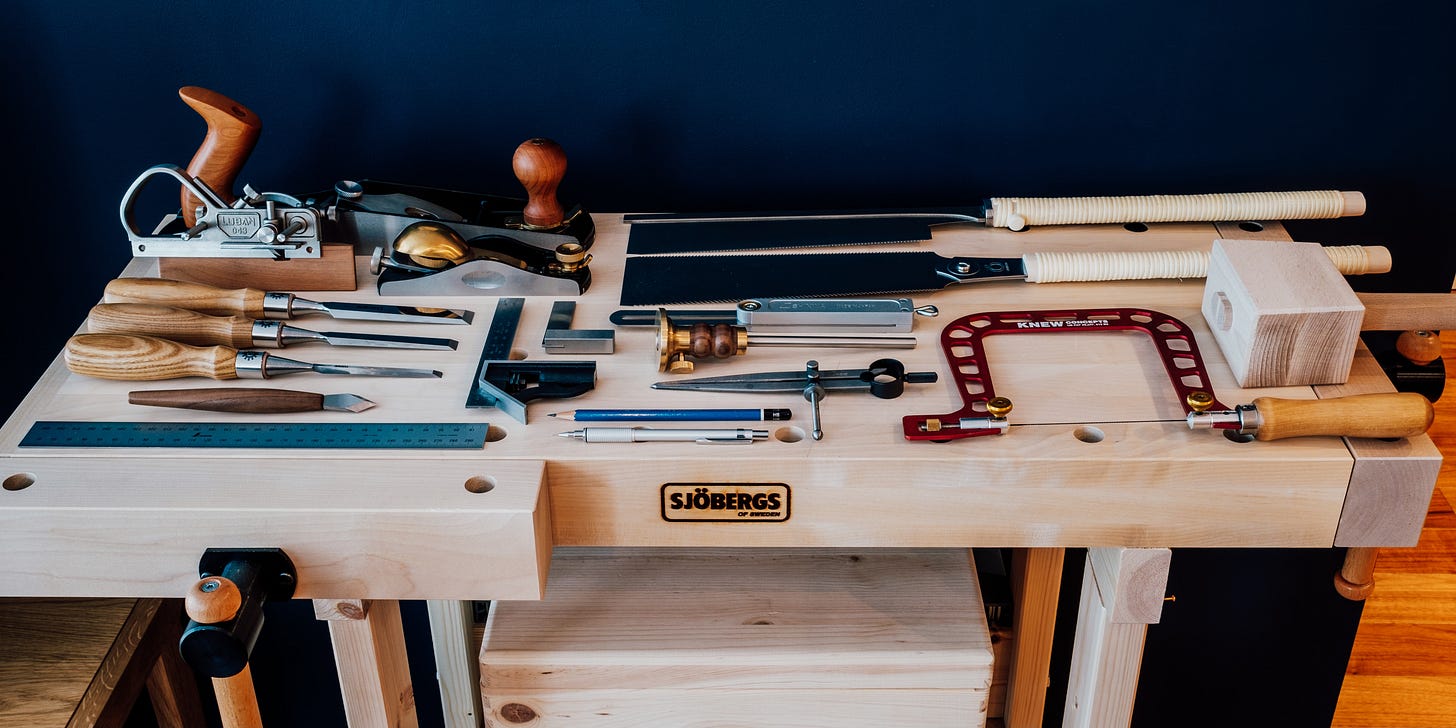Woodworking is a never ending pursuit of education, at least it is for me. I have a constant thirst for knowledge, be it learning a new joinery technique or understanding the evolution of the workbench over two millennia. In this ongoing series, I’ll describe the lessons I have learnt through woodworking and how it has changed my approach to the craft.
In this first post, I’m going to touch on the inherent tension between buying the “right” tool when you don’t know what you don’t know.
You don’t know what you don’t know
A month after learning about hand tool woodworking, I had amassed a small collection of tools (see photo above), which from my research would be sufficient to make my first dovetail box. Of those tools, I no longer own twelve of them.
I’ve alluded to some of these tools in previous posts, but here is a quick run down of which I’ve since sold and the main reasons why:
Quangsheng No. 62 Low Angle Jack Plane and No. 60 1/2 Block Plane - these are mid-tier, Made in China tools. For a seasoned veteran of hand tool woodworking, you could build complex furniture with them without issue. For me, as a novice, they were frustrating to use and required fettling that I had yet to learn how to do. I eventually replaced these with their Lie-Nielsen equivalents (the No. 60 1/2 was actually replaced with a No. 102) and the difference was stark.
Quangsheng No. 043 Plough Plane - this lasted much longer in my toolkit, it is a great tool, but I have recently replaced it with a left handed equivalent from Veritas, which better fits my needs.
Narex Richter Bevel Edge Chisels (1/4”, 1/2” and 3/4”) - in the “Cutting Tools” post, I briefly discussed that I found the balance of the Narex chisels uncomfortable for cutting dovetails. I also found that I rarely, if ever, used the 3/4” size. Other than that, they’re excellent chisels (except the backs aren’t as flat as the manufacturer claims) for a reasonable price. But the Lie-Nielsen’s are superior, in my experience.
Narex Marking Knife - in the “Marking and Measuring” post, I mentioned this marking knife. It would roll around on the workbench and the blade wasn’t long enough to fit between narrow dovetails. The Japanese marking knife that replaced it solved both these problems.
Quangsheng Marking Gauge - nothing inherently wrong with this marking gauge, except the micro-adjustment mechanism was unintuitive to use and I’m still not convinced I know how to use it. The Tite-Mark marking gauge is much better in that respect.
Shinwa Sliding Bevel (200 mm) - a perfectly good sliding bevel that locked in position well. I just didn’t use it once I purchased the Veritas dovetail saddle.
Shinwa Dividers (300 mm) - a serviceable pair of dividers, but far too cumbersome for laying out dovetails at the scale I work at. The smaller Starrett dividers fit the brief better.
Pencil (HB) - the lead of this pencil would constantly break, which was incredibly frustrating. It has since been replaced with a Shinwa pencil and the lead never seems to break.
Narex Carpenters Mallet - this behemoth was loud in use when dovetailing and just didn’t feel nice to strike with. The Wood is Good round mallet that replaced has neither of these issues.
With no prior experience, I didn’t know that any of the above would be an issue for me. As it turns out, I didn’t know what I didn’t know. But I know now, and along the way I’ve learnt a lot about how I woodwork and the tools I prefer to use.
Buy once, cry once
I generally try to buy the best of something in all corners of my life. When it comes to buying tools, that’s no different, but I want to spend as little money as possible. This doesn’t mean buying the cheapest tool, but rather buying the right tool first time around. The alternative is to buy a cheaper tool only to end up replacing it with the right tool later down the line, spending more to achieve the same outcome.
Sometimes I buy the right tool from the off - I still own seven of the nineteen tools pictured above, after all - and the percentage of tools I don’t feel the need to replace has increased over time. It’s amazing what a little knowledge and experience can do to inform purchasing decisions.
As I’ve discovered, it can be difficult to know what “best” is without experiencing it first. Maybe the mantra should be “buy once, cry once if you can, otherwise buy twice, sell once”, but that hardly rolls of the tongue.
In my next post I am going to make a few hand tool woodworking book recommendations.



Interesting points Danial - I notice all your tools seem to be new or at least relatively new - have you considered buying vintage tools - planes in particular (I don’t think buying old chisels makes sense) - there are some wonderful Stanley planes in Ebay if you know what to look for (and ideally pre 1960). Glad that Substack recommended you as someone to read. Matthew
Agree, but it’s so hard to truly know yourself - what you like using, what suits your needs - until you start using the thing(s)!